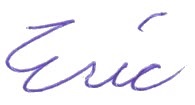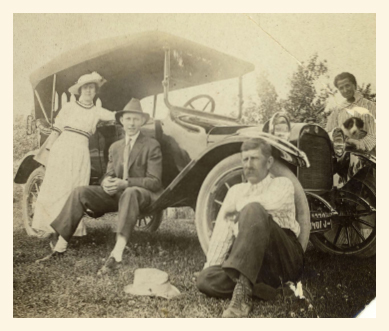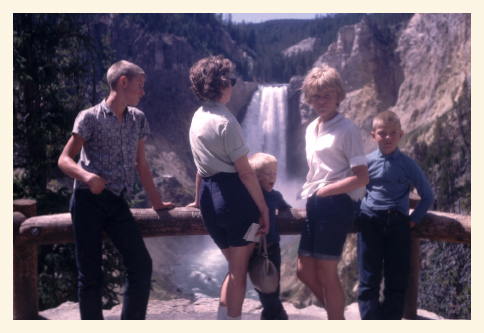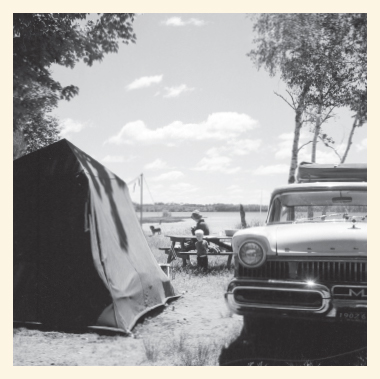By Eric Peterschmidt
Did you grow up looking forward to the next family slide show?
Did you or your parents ever take “slide” photographs? Slides were amazing things. Near perfect resolution, meaning you could blow one up into a wall-sized poster if you wanted. A transparency, which, like a negative, light could be shone through. However, as opposed to a negative, the image was a positive. Slides were also in full color. Have you ever held up a color negative to a light and tried to figure out what it is? Not trivial. Being a positive, slides provided instantly recognizable images.
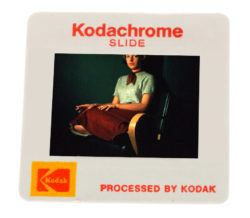 The iconic brand in slides was Kodachrome by Kodak. While Kodak made other slide film too, Kodachrome was by far the best when it came to color palette, accuracy and film stability. As Paul Simon said in his 1973 song of the same name:
The iconic brand in slides was Kodachrome by Kodak. While Kodak made other slide film too, Kodachrome was by far the best when it came to color palette, accuracy and film stability. As Paul Simon said in his 1973 song of the same name:
Kodachrome
They give us those nice bright colors
They give us the greens of summers
Makes you think all the world’s a sunny day, oh yeah
But why were slides so popular?
Why did people buy them? Well, the answer was initially cost. Back in the 1940s, the alternatives were black & white (or even more expensive color) negative film. After processing the film, negatives had to then be printed on paper, and photo paper back then was expensive and did not age very well.
Some amateur photographers, like my dad, were able to rig up darkrooms so they could do their own black and white film processing and printing. So, if you had the passion and could afford the gear, that could keep the cost down if you took a lot of pictures – especially since you only had to print the ones you liked. In fact, my dad took black & white photos well into the 1950s because he loved the darkroom process. He started experimenting with Kodachrome in the mid 1940s, with some amazing family photos. (Nerd note! Those early slides were mounted in pieces of glass as it was not until the 1950s when cardboard became the standard).
My dad took several thousand photos in the 40s and 50s – perhaps 1/3 or so were slides. While some of his photos were for work, most of them were capturing our life as a family and the lives of extended family around us. Vacations, holidays, activities around the home, visiting family. It was our life in suburban Chicago.
But the introduction of the slide had a social impact as well. While slides could be held up with your hand to a light bulb to view, a way to project them was needed. And, if done in the proper setting, they could be projected on a large screen for a family to view. The slide projector was invented, and “boom!”, the slide show was created.
It is hard for us now to imagine the significance of the family slide show.
It became a way to gather the family together. While wealthy families may have had a home movie camera and projector, most families had nothing like that – except for the radio and perhaps a TV, which was also in its infancy. Over the decades, we’ve evolved through TVs, VHS/DVD/Blu-ray players, and now streaming to watch whatever we want on TV with whoever is around. So the novelty of “gathering around” is gone. And with smartphone in hand, most people look at photos quietly, in isolation — sometimes sharing them with friends and family via text messages or social media.
But the 1950s/60s slide show was more than just a way for a family to gather to look at photos. There was something magical about it. It started with the immersiveness — the fact that everyone was viewing one image at a time – together. Here is what I mean by this. When you are by yourself and look at a photo, it triggers memories, you think of things, but you stay quiet (Hey! Even in my house, sitting in a corner talking to myself would have raised a flag or two!).
On the other hand, when you are watching a slide show with others, you still think about those memories, but it is out loud. That is something that cannot happen with a set of prints or even showing photos to more than one person using your smart phone.
Have you ever sat at a table with a group of people when someone had a new envelope of pictures? Since at any given time, as the prints were being passed around, everyone was looking at a different photo, it was difficult to really have a conversation about them. Slide shows, on the other hand, put the same photo in front of everyone at the same time. Reactions are together, triggering other comments and stories — making the moment much richer and often more satisfying.
Several times a year, my dad, after getting home from work, would say, “I have a new box of slides. After dinner, you guys set everything up.” We were pumped! The 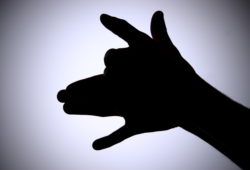 anticipation! When it was set up and the family was assembled (and I mean everyone too, as they all wanted to be a part of it), the room lights went off, and the projector came on. All eyes were focused on the only thing you could see – the white, blank screen (and of course, whenever there was a white blank screen, the kids who were sitting on the floor in front of the projector would use their hands to do “shadow puppetry.” Our favorites were bunnies and moose. Mooses? Meese?).
anticipation! When it was set up and the family was assembled (and I mean everyone too, as they all wanted to be a part of it), the room lights went off, and the projector came on. All eyes were focused on the only thing you could see – the white, blank screen (and of course, whenever there was a white blank screen, the kids who were sitting on the floor in front of the projector would use their hands to do “shadow puppetry.” Our favorites were bunnies and moose. Mooses? Meese?).
The person “driving” – that is, the person operating the projector – was in control of how the show would go. In my family’s case, it was my dad. He knew the order of the slides and what photo was next, and often would provide a brief (and often humorous) preamble about what we were all about to see. And then the photo appeared! We would react with laughter! Or, sometimes sighs, shock or even awe! The point is, that everyone was focused on that one image – immersed – and the conversation that followed dove deeper into what it was that the photo had captured. This conversation often cascaded into other connecting memories and stories. Everyone was participating and loving it.
I was talking to my brother about his recollection of these slide shows. He said they were better than going to the movies. He said too, that what made it so neat was there was no sound with the photos. Instead, we were providing the sound – the commentary.
Thinking back on it now, the memories are almost visceral
As a little boy, I loved the things we did to get the slide show gear set up and ready to go. The operation of the equipment – like unfolding the tripod legged screen (I used to pretend it was the Apollo LEM landing on the moon, as I unfolded its legs and gently touched down). Getting chairs ready, closing drapes and telling everyone to come in.
But the KING of the “gear” was the projector. Our first projector was an Argus. Pretty simple operation, really. However, it had a revolving plate in the middle that had two openings for slides. This allowed it to hold two slides at a time – one that was being projected, and the other being in the “on deck” position. This meant the family was enjoying one slide while “the driver” was selecting and inserting the next one.
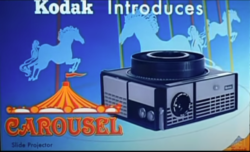 But then one day, my dad came home with the KING of the KING of projectors. A Kodak Carousel model 550. The year was probably 1961. To me, as a 6 year old, it was a living, breathing entity. Solid metal casing. Special compartment for cables. A wired remote. A carousel that we would fill with slides that would latch with a “ka chunk” to the projector top. Such precision. The sounds of it were extraordinary too. The cooling fan that came on with the power. The sound of advancing forward — or backwards, which was slightly different than the forward. The focusing with the remote control. Just to add to the atmosphere, was the cigarette smoke from my parents as it wafted through the beam of light. I remember it like it was today.
But then one day, my dad came home with the KING of the KING of projectors. A Kodak Carousel model 550. The year was probably 1961. To me, as a 6 year old, it was a living, breathing entity. Solid metal casing. Special compartment for cables. A wired remote. A carousel that we would fill with slides that would latch with a “ka chunk” to the projector top. Such precision. The sounds of it were extraordinary too. The cooling fan that came on with the power. The sound of advancing forward — or backwards, which was slightly different than the forward. The focusing with the remote control. Just to add to the atmosphere, was the cigarette smoke from my parents as it wafted through the beam of light. I remember it like it was today.
If you too grew up with a Carousel projector, or just wanted to see and hear what I am talking about, watch this classic Mad Men scene where the Kodak Corporation came to Don Draper’s ad company to help them name, what they were calling at the time, “The Wheel” (https://www.youtube.com/watch?v=suRDUFpsHus). By the way, the model used in that scene is the same one we had.
You know….it’s too bad these kinds of immersive moments with family photos can no longer occur.
Or can the family slide show still exist after all?
As it turns out, they can! I have continued to do slide shows with my family and friends, and so can you. What is even more exciting, is that you can do them virtually, with nothing more than your computer (or phone/tablet), some old family photos and a Zoom account. Especially in times when gathering together is challenging, and with family members scattered all over the country or the world, it is a fantastic thing to do.
Invite some family members who would love to wax nostalgic and have fun. Many of the attributes discussed above – the immersiveness, the group focus on a single photo at a time, and the free-flowing conversation – will happen. In fact, the opportunity and indeed the value of doing it today is greater than it was when I did it as a kid. Back then, we looked at the photos that had recently been taken – so they were fresh in our mind. Today, with a Zoom session and families virtually gathered, it is an opportunity to revisit those old photos and watch them magically trigger memories and stories. So important to do this, before those memories and stories are lost forever.
How to do it? I’ve got more to share with you about that later.
I am so fortunate that I grew up with the amazing family I have, doing amazing things like slide shows with them all. I encourage you all to try this. Especially with elders, as it is a way to stay in touch and keep them engaged. You will all come away with a greater understanding of who your people are.
